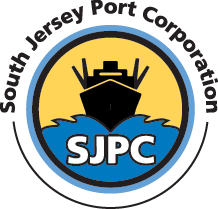The successful 30-year partnership between Clipper Americas shipping lines of Copenhagen and the South Jersey Ports was marked – not by bands or the popping of champagne corks – but by the orchestra of cranes, forklifts, and cargo-moving equipment as crews off-load rolls of high-quality European steel coils, tin, and structural steel from Clipper ships. The materials are then instantly dispatched and transported to manufacturers and construction projects throughout the heartland of America and Canada.
“Our business and tonnage grew tremendously at the South Jersey Ports from one ship a month 30 years ago, to now when we have three to four off-loading in Camden in a month,” said Peter Svensson, Senior Vice President, Clipper Americas. “Tonnage to Camden grew from under 200,000 tons a year to over 1 million last year. Our customers, especially our specialty steel customers, expect quality service and that is what our partnership delivers.”
It’s a partnership that has prevailed – and continued to thrive – over several economic recessions, a near-depression, changes in trade policies and a global pandemic that leaves persistent impacts.
Now add to the challenges-climate change and the need for everyone, from individuals to large corporations, to reduce their carbon footprint to protect our planet. “We survived 50 years in this industry by adapting to the challenges before us,” Peter explained. “Climate change is real. Reducing carbon emissions is a shared priority for our company and South Jersey Ports,” said Peter. “Working with South Jersey Port on our dunnage recycling program has virtually saved a small forest. Our fleet will continue to be among the most energy-efficient on the seas.”
Clipper is attacking the problem on a variety of fronts including investing in an increasingly efficient fleet with dramatically lower CO2 emissions and the dockside recycling of dunnage.
In the past, it was simply cheaper to dispose of the wood dunnage used in transit to support steel cargo than hauling back to the originating port. The wood dunnage that went into the landfill was replaced by freshly cut lumber. Climate concerns have changed that. The wood dunnage is now loaded by crews into cargo containers and returned to the originating port, and as the wood loses its viability, it is being replaced by plastic and rubber dunnage with a greater shelf-life that can be recycled.
New ratings of ships for CO2 emissions, set by the European Common Market, go into effect in 2024 that will impose increasing financial penalties on levels of CO2s the vessel releases into the atmosphere. The lower the efficiency rating of the ship, the more it must pay to sail, giving a competitive edge to ships with higher efficiency ratings and lower CO2 emissions.
“We’re confident our current fleet will be rated among the most highly efficient,” predicted Peter. “I’m also confident that as technologies evolve and our fleet turns over, it will continue to be a leader in reducing emissions. It’s good business. It’s good for the environment. It’s the right thing to do as we and our families share this planet too.”
It’s a business axiom that has been the foundation of the partnership between Clipper and the South Jersey Ports. “As a marine terminal operator, we can’t control global economics, trade policy or pandemics but we sure can control two things: our carbon footprint and the quality of customer service that we and our partner Clipper and the stevedores provide to our mutual customers,” said Andy Saporito, Executive Director and CEO of the South Jersey Port.
Good customer service translates into higher efficiency and lower emissions. “Get in, get off,” Peter explained. “The quicker we get into the port, off-load, and get off to sea, the more efficient our ships run which lowers emissions. Good for business. Good for the environment.”
Clipper is a vital link in the steel supply chain to North America. The flow of specialty metal products from the steel and tin plants throughout Europe course through the ports of Belgium to Clipper’s ships and ultimately to manufacturers in North America for cars, appliances, building, and highway construction.
Over three decades, South Jersey Port’s Balzano Marine Terminal in Camden, New Jersey became a franchise port of call for Clipper. It’s importance and tonnage grew, especially in winter months, as shippers of European specialty steel for manufacturers along the Great Lakes found the Camden port a reliable, efficient, and skilled replacement for the Saint Lawrence Seaway. Now “winter-steel” business at Camden is growing towards a year-round port of choice.
“Location is important, and Camden has excellent road and rail connections to the industrial heartland, everything is within hours of our terminals – a day at most,” said Saporito. “But the x-factor is the partnership and the cargo expertise that has been forged over these decades with Clipper, the stevedores, and South Jersey Port. There is a seamless relationship with one goal: a happy customer keeps coming back and spreads the word to new customers.”



